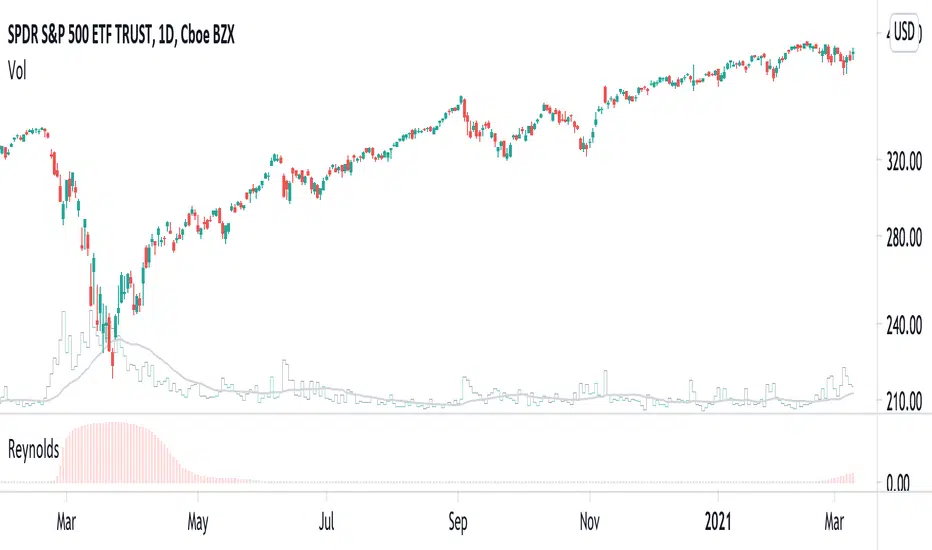OPEN-SOURCE SCRIPT
Reynolds warning rate

In fluid mechanics, the Reynolds number is the ratio of inertial forces to viscous forces within a fluid. Laminar flow occurs at low Reynolds numbers (i.e., viscous forces are dominant), whereas turbulent flow occurs at high Reynolds numbers (i.e., inertial forces are dominant). In the Turbulence indicator, I define that laminar flow occurs when simple moving averages have no interactions. In contrast, turbulent flow occurs when simple moving averages have chaotic interactions (i.e., irregular crossing and convergence).
Here, I calculate an economical analog of the Reynolds number developed by Jakimowicz and Juzwiszyn (2015). Furthermore, I propose the Reynolds Warning Rate, given by a ratio of short- and long-term Reynolds number.
The higher Reynolds Warning Rate indicates that price movement is going to a turbulence phase, and the market is under a possible systemic risk.
Reference:
Jakimowicz A, Juzwiszyn J (2015) Balance in the turbulent world of economy. Acta Physica Polonica A 127, 78–85.
Here, I calculate an economical analog of the Reynolds number developed by Jakimowicz and Juzwiszyn (2015). Furthermore, I propose the Reynolds Warning Rate, given by a ratio of short- and long-term Reynolds number.
The higher Reynolds Warning Rate indicates that price movement is going to a turbulence phase, and the market is under a possible systemic risk.
Reference:
Jakimowicz A, Juzwiszyn J (2015) Balance in the turbulent world of economy. Acta Physica Polonica A 127, 78–85.
Skrip sumber terbuka
Dalam semangat sebenar TradingView, pencipta skrip ini telah menjadikannya sumber terbuka supaya pedagang dapat menilai dan mengesahkan kefungsiannya. Terima kasih kepada penulis! Walaupun anda boleh menggunakannya secara percuma, ingat bahawa menerbitkan semula kod ini adalah tertakluk kepada Peraturan Dalaman kami.
Penafian
Maklumat dan penerbitan adalah tidak dimaksudkan untuk menjadi, dan tidak membentuk, nasihat untuk kewangan, pelaburan, perdagangan dan jenis-jenis lain atau cadangan yang dibekalkan atau disahkan oleh TradingView. Baca dengan lebih lanjut di Terma Penggunaan.
Skrip sumber terbuka
Dalam semangat sebenar TradingView, pencipta skrip ini telah menjadikannya sumber terbuka supaya pedagang dapat menilai dan mengesahkan kefungsiannya. Terima kasih kepada penulis! Walaupun anda boleh menggunakannya secara percuma, ingat bahawa menerbitkan semula kod ini adalah tertakluk kepada Peraturan Dalaman kami.
Penafian
Maklumat dan penerbitan adalah tidak dimaksudkan untuk menjadi, dan tidak membentuk, nasihat untuk kewangan, pelaburan, perdagangan dan jenis-jenis lain atau cadangan yang dibekalkan atau disahkan oleh TradingView. Baca dengan lebih lanjut di Terma Penggunaan.